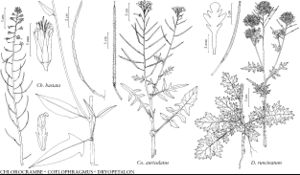Coelophragmus auriculatus
in H. G. A. Engler, Pflanzenr. 86[IV,105]: 157. 1924.
Plants glabrous or sparsely to densely pilose, at least proximally. Stems (2–) 3–12 (–15) dm. Basal leaves soon withered. Cauline leaves: (proximal and median) petiole 1–6 cm, shorter distally; blade oblanceolate to obovate, (2–) 3–12 (–17) cm × (15–) 25–60 (–85) mm, (smaller distally), base auriculate to amplexicaul, margins pinnatifid to runcinate, lobes: lateral ovate to lanceolate; terminal larger than lateral. Racemes densely flowered. Fruiting pedicels straight or slightly curved-ascending, 5–10 (–14) mm, glabrous or pubescent. Flowers: sepals 4–5 × 1–1.5 mm, sparsely pilose; petals 6–10 × 1.5–2.5 mm, gradually narrowed to clawlike base, margins entire, glabrous; median filament pairs 2.5–4 mm, glabrous; anthers 1–1.5 mm. Fruits 2–4.2 (–5.3) cm × 0.5–0.7 mm; valves glabrous or pilose; style 0.5–2.5 mm. Seeds yellowish, 0.4–0.5 × 0.3–0.4 mm.
Phenology: Flowering Mar–Nov.
Habitat: Hillsides, shallow washes, calcareous grounds, thickets, scrubby pine and oak woodland, gravelly flats
Elevation: 1200-2400 m
Distribution

Tex., Mexico (Chihuahua), Mexico (Coahuila), Mexico (Durango), Mexico (Nuevo León), Mexico (San Luis Potosí), Mexico (Zacatecas)
Discussion
Collections of Coelophragmus auriculatus from Texas are known primarily from Brewster and Hudspeth counties.
Selected References
None.
Lower Taxa
"elongated" is not a number."thick" is not a number."dm" is not declared as a valid unit of measurement for this property."dm" is not declared as a valid unit of measurement for this property.
